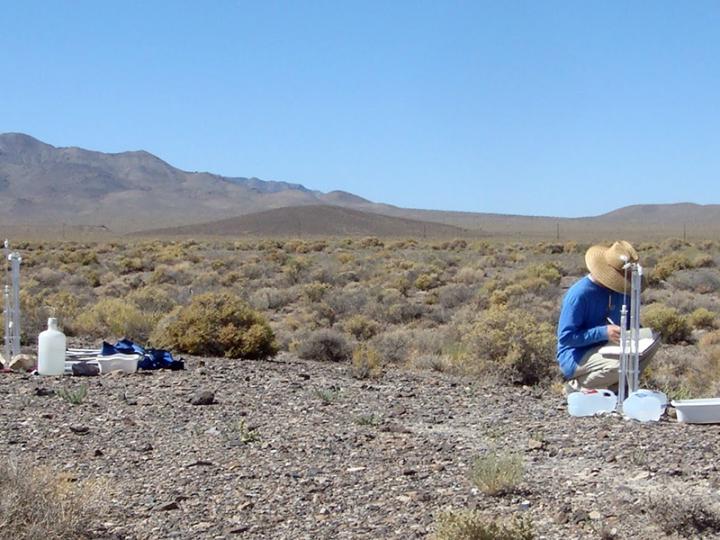
Credit: Judith Turk
Soils in deserts are very different from those found anywhere else. Extreme temperatures, little water and limited plant matter make an unusual environment. With little dead plant material to decompose and create a rich layer of organic matter, desert soils are unique.
Judith Turk, an assistant professor at the University of Nebraska-Lincoln, studies the top layer of desert soils, called the vesicular horizon. This surface layer of the soil is common in deserts and contains pores of different shapes, called vesicles and vughs.
“These horizons are important because of their role in many processes,” Turk says. “Vesicular horizons determine how much water soaks into the soil and how much runs off. Since they occur in deserts, they control the distribution of the most limiting resource, which is water.”
Vesicular pores are spherical, look a bit like bubbles, and are not connected to each other. Vughs are similar but more irregular in shape, almost like a clump of bubbles that have not fully separated from each other.
Turk wanted to learn how these horizons form across different desert soils. In their most recent experiment, they chose small plots of the soils and took samples. They then crushed the soil so the formation of pores would have to start from scratch. They checked the porosity of the soils over the course of a year to compare.
“First, we found that infiltration rates were lowered as a result of disturbance,” Turk explains. “This would normally not be surprising, since disturbance compacts the soil, reducing porosity, and breaking up the pore networks that water flows through.
“However, the pores in V horizons are different,” she says. “Most of the pores are not connected with each other and therefore contribute little to permeability of the soil. So, we weren’t sure how disturbance would affect these horizons.”
She adds that what did surprise them was how a soil’s texture determined how well its porosity in this soil layer came back. They assumed that a soil with more silt would be better for vesicle formation but found vesicles formed more rapidly in relatively sandy soils.
“The capacity for vesicular pores to reform within a year after the V horizon is disturbed is something that is interesting,” Turk says. “The post-disturbance V horizons being thinner with smaller pores tells us that what we observed in the undisturbed soils takes time to form.”
It is important to study these soils because semi-arid lands cover about one third of the planet’s land area. Soils with V horizons are often disturbed because populations of cities in arid environments are growing. There is construction of solar and wind farms, and these areas are popular for military exercises.
It’s vital to take the researchers’ findings into account when planning to disturb the soil. This allows people to understand how the soil might behave after the disturbance.
Turk plans to continue this research in the future. She would like to see an experiment done over a longer time scale to watch the newly formed layers blend into the undisturbed surrounding soil.
“Many people are surprised to learn that there are interesting soils in the desert,” she says. “When I moved to California for graduate school, I fell in love with the desert lands of the western US. In the desert you can see the land surface and it’s easy to imagine the processes that have built the soil landscapes that we see today.”
###
Read more about this work in the Soil Science Society of America Journal. This research was funded by the United States Department of Agriculture’s Natural Resources Conservation Service and the National Science Foundation.
Media Contact
Rachel Leege
[email protected]
Related Journal Article
http://dx.




